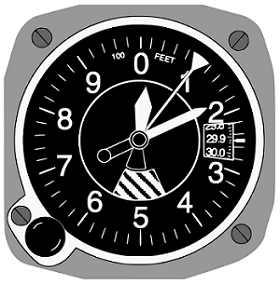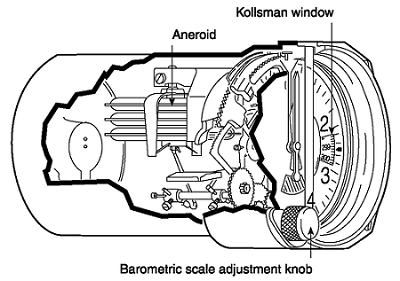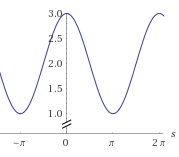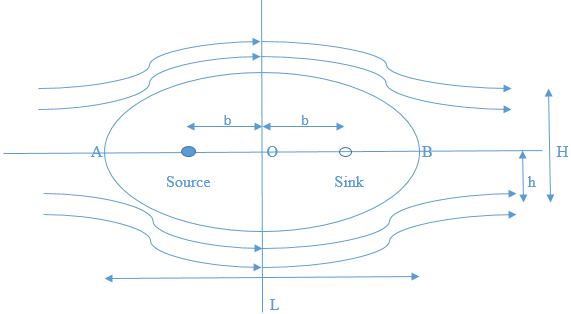331
Points
Questions
27
Answers
67
-
Asked on 18th November 2020 in Systems.
Altimeter used in an aircraft is a pitot-static system. Pitot-static system measures the total pressure created by the forward motion of the aircraft and also the static pressure of the surrounding atmosphere.
A pitot-static tube of this system is located at a suitable position on the aircraft for the airstream to sense, the static pressure of the atmosphere and total or pitot pressure. A pitot tube is opened at the forward end is used to measure the total air pressure from the forward motion of the aircraft. Static tube has small holes at measured positions around the tube, through which air at the surrounding atmosphere is entered. These two tubes are placed parallel to each other vertically.
The standard sea-level atmospheric pressure is 14.7 lbf/in2 which is 29.921 in Hg or 1013.25 mbar. In altimeter aneroid barometer is used. In an aneroid barometer, the pressure sensing is done on an evacuated metal capsule through the static tube of the pitot-static system. The instrument is prevented from collapsing through a strong leaf spring, because of pressure difference inside and outside of this capsule. At equilibrium, the outside pressure is balanced by the tension of the spring. The aneroid barometer with a scale markings makes the altimeter.- 1407 views
- 1 answers
- 0 votes
-
Asked on 3rd September 2020 in Flight mechanics.
Dihedral: It is an angle formed by the wings which is upward and horizontal of the wing of a fixed-wing aircraft.
Anhedral: It is an angle formed by the wings which is downward and horizontal of the wing.
Dihedral angle has a stabilizing effect on an aircraft. Increasing the dihedral angle of an aircraft increases the dihedral effect. Dihedral effect is a rolling moment which is a resulting from a non-zero angle of sideslip.
Dihedral angle and dihedral effect have usage in aircraft stability analysis, stability, and wing clearance between the wingtip and runway.
Anhedral wing can be found on high mounted wings to cancel out some of the dihedral effect, for more easily maneuvering of an aircraft.
- 1185 views
- 1 answers
- 0 votes
-
Asked on 3rd August 2020 in Flight mechanics.
Lift coefficient: Lift coefficient is equal to the lift produced divided by dynamic pressure times wing area or surface area. We can determine the value of lift from the wind tunnel test by setting the velocity of air, density, and measuring the area of the wing surface. This value of the lift can be used to determine the lift coefficient. Lift can be then predicted by different sets of velocity, density, and area conditions by using the equation. Lift Coefficient also contains the effect of air viscosity and compressibility. For low Mach numbers compressibility effects, are negligible. However, compressibility effects increase with an increase in Mach number. Viscosity and compressibility effects should be the same between the measured case and predicted case. For viscosity Reynolds number of experimental real case should be close.
Drag coefficient: Drag coefficient of a surface is equal to the drag divided by the dynamic pressure times the area. Like lift coefficient drag coefficient can also be determined by wind tunnel by setting the value of viscosity, density, and area. After obtaining the drag coefficient drag can be predicted by setting different values of velocity, density, and area using the drag equation. Like the lift coefficient, the drag coefficient is also affected by viscosity and compressibility. Therefore, these two effects should be the same for the measurement and predicted cases. Mach number should be matched for a higher Mach number as the compressibility effect increases. With an increase in Mach number. At a supersonic speed, shock waves are also produced which are accountable for wave drag in the drag coefficient. For viscosity effects, the Reynolds number should be close to experimental and real measurements. For an aircraft, induced drag is also to be considered. The total coefficient of drag for an aircraft is equal to the sum of the drag coefficient at zero lift and induced drag coefficient.
- 1969 views
- 1 answers
- 0 votes
-
Asked on 17th July 2020 in Aeronautics.
Sonic boom:
A sonic boom is produced when an object travels through the air faster than the speed of sound. When an aircraft travels in air it creates a series of pressure waves which are in front and behind the aircraft. The pressure waves travel at the speed of sound. As the speed of aircraft increases, these waves are forced together and are compressed. These words merge to form a single shock wave that travels at the speed of sound.
The shock wave starts at the nose of the aircraft and ends at the tail. Pressure rises at the nose which decreases to a negative pressure at the tail which is followed by returning to normal pressure after the passing of the object. Boom is experienced when there is a sudden change in pressure. There is a distinctive double boom for a supersonic aircraft. When there is initial pressure-rise and it reaches to the observer and another when pressure comes back to normal.
Sonic boom is a thunder-like noise when aircraft flies overhead faster than the speed of sound.
Mach cone:
When aircraft smoothly flies at a speed greater than Mach 1, then shock waves and area bounded by the sides of these shock wave forms a Mach cone.
- 1558 views
- 1 answers
- 0 votes
-
Asked on 13th July 2020 in Flight mechanics.
There is a large increase in drag near Mach 1, that is when aircraft are approaching the speed of sound. Mach number at which drag starts to rise rapidly is known as drag divergence Mach number. The large increase in drag is due to an extensive region of supersonic flow over the airfoil forming into shock waves. These shocks create severe flow separation downstream of the shock wave, which results in a large increase in drag.
These shocks create severe flow separation downstream of the shock wave, which results in a large increase in drag. Large drag rise near Mach 1 can be reduced by the use of thin airfoils and swept wings. Other is through the use of supercritical airfoil and area rule. The cross-sectional area of any aircraft has some abrupt changes with discontinues in the regions of the wing section. However to have a less drag variation of cross-sectional area should be smooth and there should not be any discontinuities. Therefore, in the regions of the wings and tails, the cross-sectional area of the fuselage should decrease for compensation of addition of wing and tail cross-sectional area. This leads to an area distribution within a relatively smooth variation.
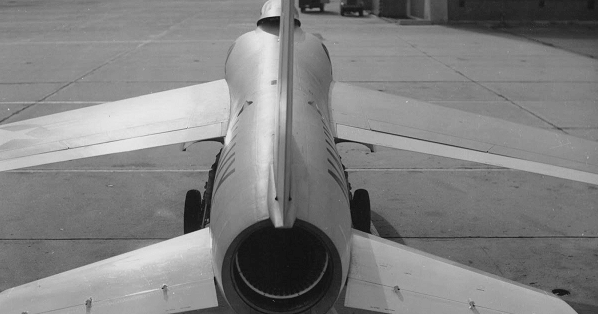 Cross sectional area of fuselage is decreased at wings and tail to apply area rule
Cross sectional area of fuselage is decreased at wings and tail to apply area ruleThis design philosophy is known as area rule. The area rule helps to overcome the sound barrier. It is a technique to reduce an aircraft’s drag at transonic and supersonic speeds, particularly in between 0.75 to 1.2.
- 1219 views
- 1 answers
- 0 votes
-
Asked on 25th May 2020 in Astronomy.
Solar system consists of the sun, the eight planets, dwarf planets and smaller bodies that orbits the sun. In sequential order from the sun they are Mercury, Venus, Earth, Mars, Jupiter, Saturn, Uranus and Neptune. Moon is orbiting the sun. In between Mars and Jupiter there are larger number of irregular shapes in space that orbits the sun. Asteroids are made of rocks and metals. Eight planets are categorized into two groups terrestrial and Jovian. Terrestrial planets are Mercury, Venus, Earth and Mars, are made of rock materials whose surfaces are solid. They are relatively small. Jovian planets are Jupiter, Saturn, Uranus and Neptune. Of these Jupiter and Saturn are gas giants. Beyond Neptune are the dwarf planets such as Pluto and comets. Kuiper belt lies beyond Neptune is a region of space filled with millions of objects made up of ice. Pluto is known to be the largest known member of the Kuiper belt.
- 1247 views
- 1 answers
- 0 votes
-
Asked on 31st December 2019 in Flight mechanics.
The altitude at which maximum rate of climb is zero is defined as a absolute ceiling of an airplane. It is the altitude at which the engines are operating at maximum thrust.Service ceiling is the altitude at which maximum rate of climb is 100 ft/min.It represents practical upper limit of a steady,level flight.
- 1843 views
- 1 answers
- 0 votes
-
Asked on 30th December 2019 in Aerodynamics.
p\left ( s \right )=2+sin\left ( \frac{\pi}{2}+s \right )
The graph of the above function is
From the graph we easily see that at s = \pi there will be adverse pressure gradient.So the separation will start from this point.
- 1494 views
- 1 answers
- 0 votes
-
Asked on 30th December 2019 in Aerodynamics.
Slenderness ratio of the Rankine oval is L/H
L=2 OA =2 OB = \sqrt{b^{2}+\frac{\Lambda b }{\pi V_{\infty}}}
L=2\sqrt{1+\frac{50}{\pi\times29 }} \\=2.489\;m
\left ( \frac{h}{b} \right )=\frac{1}{2}\left \{ \frac{h^{2}}{b} -1\right \}tan\left \{ 2\left ( \frac{\pi V_{\infty} b}{\Lambda} \right )\frac{h}{b} \right \} \\\Rightarrow \left ( \frac{h}{1} \right )=\frac{1}{2}\left \{ \frac{h^{2}}{1}-1 \right \}tan\left \{ 2\left ( \frac{\pi V_{\infty }1}{\Lambda} \right ) \frac{h}{1}\right \} \\\Rightarrow h=\frac{1}{2}\left \{ h^{2}-1 \right \}tan\left \{ 2\left ( \frac{\pi 29}{\Lambda} \right )h \right \} \\\Rightarrow h=\frac{1}{2}\left \{ h^{2}-1 \right \}tan\left \{ \left ( \frac{\pi 58}{50} \right )h \right \} \\\Rightarrow 2h=\left ( h^{2}-1 \right )tan\left \{ \left ( 3.644 \right )h \right \}
Solving for h, h = 0.5755 = 2h = H = 1.151
Therefore slender ratio of the Rankine oval is
\frac{L}{H}=\frac{2.489}{1.151}=2.16246
- 1515 views
- 1 answers
- 0 votes
-
Asked on 10th November 2019 in Flight mechanics.
Take off distance can be given as S_{LO}=\frac{1.44W^{2}}{g \rho_{\infty}SC_{L,max}T}Take-off distance is directly proportional to the square of weight of the aircraft therefore if the weight is increased by 30 \% take off distance will also increase to 1.69 that is approximately 70\%.
- 1566 views
- 1 answers
- 0 votes


